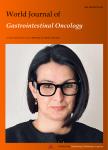Multiple primary colorectal cancer: Individual or familial predisposition?
多原发性大肠癌:个人或家族倾向?作者机构:Department of Gastreoenterology Gregorio Maranon University Hospital Department of Surgery 12 de Octubre University Hospital
出 版 物:《World Journal of Gastrointestinal Oncology》 (世界胃肠肿瘤学杂志(英文版)(电子版))
年 卷 期:2015年第7卷第12期
页 面:434-444页
核心收录:
学科分类:1002[医学-临床医学] 100214[医学-肿瘤学] 10[医学]
基 金:Mutua Madrilena Foundation No.2012-0036
主 题:Multiple primary colorectal cancer Synchronous colorectal cancer Metachronous colorectal cancer Chromosomal instability Microsatellite instability CpG island methylator phenotype
摘 要:Colorectal carcinoma(CRC) is one of the most frequent cancers. Along the surface of the large bowel, several foci of CRC may appear simultaneously or over the time. The development of at least two different tumours has been defined as multiple primary CRC(MPCRC):When more than one tumour is diagnosed at the same time, it is known as synchronous CRC(SCRC), while when a second neoplasm is diagnosed some time after the resection and/or diagnosis of the first lesion, it is called metachronous CRC(MCRC). Multiple issues can promote the development of MPCRC, ranging from different personal factors, such as environmental exposure, to familial predisposition due to hereditary factors. However, most studies do not distinguish this dichotomy. High- and low-pentrance genetic variants are involved in MPCRC. An increased risk for MPCRC has been described in Lynch syndrome, familial adenomatous polyposis, and serrated polyposis. Non-syndromic familial CRCs should also be considered as risk factors for MPCRC. Environmental factors can promote damage to colon mucosae that enable the concurrence of MPCRC. Epigenetics are thought to play a major role in the carcinogenesis of sporadic MPCRC. The methylation state of the DNA depends on multiple environmental factors(e.g., smoking and eating foods cooked at high temperatures), and this can contribute to increasing the MPCRC rate. Certain clinical features may also suggest individual predisposition for MPCRC. Different etiopathogenic factors are suspected to be involved in SCRC and MCRC, and different familial vs individual factors may be implicated. MCRC seems to follow a familial pattern, whereas individual factors are more important in SCRC. Further studies must be carried out to know the molecular basis of risks for MPCRC in order to modify, if necessary, its clinical management, especially from a preventive point of view.



